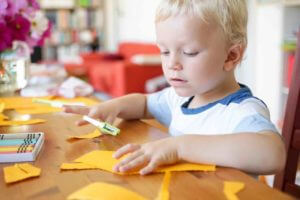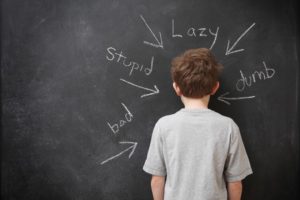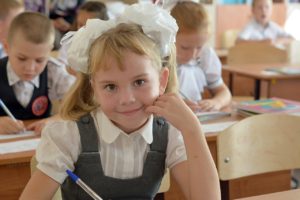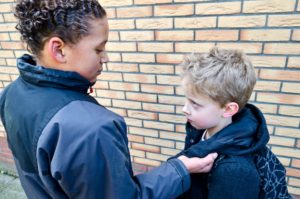Maria Montessori was born in Italy in 1870. She was one of the first women with an academic degree. In the course of her work at the curative education institute in Rome, the doctor developed her own educational concept. With numerous, appealing materials and a respectful approach, school children were now to be treated in a completely new way. With her views, Maria Montessori was far ahead of her time. It is therefore not surprising that her concept still enjoys great popularity today.
Along with the Waldorf School, the Montessori School is one of the most important alternatives to the mainstream school system.
Table of contents
Differences To The Regular School
For many years, Montessori materials have also been found in mainstream schools. Unfortunately, it often lies around unnoticed or is misused. The golden bead material, for example, is often used as a visual aid in mathematics lessons, even though the teachers have not been trained in its use.
The fact that Montessori’s ideas are generally accepted is praiseworthy. However, the use of the material in regular classes should be well thought out and prepared accordingly. With the right background knowledge, much more can be learned from the material, so that the child’s learning process is stimulated in a child-friendly way.
Because the Montessori concept is difficult to implement in regular schools, there are now separate Montessori schools. They differ in many ways from what we know from regular schools.
In the following we would like to introduce you to some of these differences – and at the same time advantages.
Spoilt For Choice
In Montessori classes and schools, children can choose from a variety of child-friendly materials. These correspond to the original materials as Montessori designed them in her time. Means:
-
Simple, clear design.
-
No distracting elements.
-
Muted, simple colors.
-
Illustration of thought processes.
Keyword Atmosphere
Maria Montessori attached importance to a prepared learning environment. On the one hand, this means that suitable materials are made available and checked for their condition. On the other hand, the child should be in a room that has a motivating effect and at the same time is not distracting.
Therefore, classrooms in Montessori schools are bright and friendly without being cluttered. The walls are painted in color and often have pictures on them. Many shelves with materials line up. These are presented in such a way that they arouse curiosity and invite children to try them out.
Instead of rows of tables, the children sit together in small groups. In addition, there is at least one large, open area to work on the floor. This area is carpeted and, if possible, always looks neat as well as tidy.
A couch adds to the pleasant ambiance. Reading nooks and places for class pets are also common. The living room atmosphere is familiar to children from home and makes them feel a bit more open. Still, they know that school is a place to learn and work.
The Teaching Concept
Montessori teaching is characterized by free work. It is true that there are phases in which new things are explained. During the practice time, however, the children are allowed to decide for themselves what they would like to work on. The teacher only intervenes if the child asks for help or becomes obviously frustrated. Otherwise, they are given plenty of space and time to learn at their own pace. Unlike in a regular school, the child’s train of thought is not interrupted. Children who, for example, calculate more slowly than others can continue their exercises in peace and at their own pace. Therefore, they are more motivated to work independently instead of coloring off results from neighbors.
In addition, Montessori schools refrain from grading with numbers. Corresponding report cards, as one is used to from regular schools, do not exist either.
In the semi-annual report card discussion, the teacher, parents and child discuss the current level of achievement with each other. To be more precise, it is actually less about performance (since there are no grades) than about the competencies already acquired. Thus, the parents receive differentiated feedback and know exactly where the child’s strengths and weaknesses lie. The children then receive a letter in which the competencies they have achieved are recorded. Stumbling blocks, future tasks and weaknesses are also described in it.
At the end of the school year, there is a kind of annual report card. The information on the development and learning process – like the letter at the end of the semester – does not require any grades. This IzEL, as it is also called, lists all the important competencies that a schoolchild should master at the appropriate age. These competencies are divided into the following groups (or similar):
-
Behavior in the community.
-
Work behavior.
-
Presentation and narrative circle.
-
Cosmic education.
-
Language.
-
English.
-
Mathematics.
-
Music.
-
Art.
-
Sports.
The individual competencies are broken down in detail to indicate which processes the child has already mastered.
Example.
Mathematics – Subtraction.
I can calculate tasks such as 8 – 4.
Next to it, there is a four-part scale from I can do it for sure (or similar) to I can’t do it yet (or similar). The teacher has marked the appropriate box based on his observations.
Teaching In Mixed-Age Classes
Mixing age groups within classes is common at Montessori schools. Approximately two to four grade levels are in a class community where they go through the daily classroom routine together.
Of course, depending on the age group, students are given different assignments that correspond to the curriculum of each grade level.

The concept of the mixed-age class works very well if, for example, the teacher refrains from frontal teaching. This makes it possible to work on a new subject area with a small group of students from the same grade level, while the other children consolidate what they have already learned in free work.
Because the work is done in a small group, the teacher recognizes misunderstandings at an early stage. He has a better overview of whether the new material has been understood or not. In addition, the children in the small group are able to concentrate better without being distracted by underachieving children.
Importance Of The Weekly Schedule
In most Montessori schools, the weekly schedule replaces the homework book. In it, children find assignments for the entire week and for all subjects. Because there are a variety of materials for each major assignment, the child can select them according to grade level and personal knowledge level. This makes it possible to provide each child with an individual mix of learning materials.
Everyday Life At The Montessori School
In The Mainstream School There Are Essentially Two Main Phases Of Teaching
-
Acquiring New Material
-
Practicing What Has Been Learned
These teaching phases are characterized by frontal teaching, individual and group work. Occasionally there are weekly plans, free work phases and other forms of instruction. The curriculum, i.e. the entire subject matter, is distributed over the school year by the teachers in advance. Therefore, it is exactly determined when what will be taught.
This is different in the Montessori school. First, the children practice mostly in free work. Second, the curriculum is much more individualized. One thinks here of the developmental phases according to Montessori. According to this, every child is receptive to some kind of learning process at a certain and often different time.
This difference between regular and Montessori schools is expressed in the daily routine.
Daily Routine
The school day normally begins with a free work phase. Depending on their personal state of mind, the children can then occupy themselves with their currently favored materials.
In the second phase, the children are given different activities to work on, depending on their grade level.
Before the end of the school day, the children can devote themselves to deepening what they have learned in free work. In the higher grades, the events of the school day are recorded in the daily log.
Each child should be able to work according to his or her level of development. If the child has decided to deepen his or her knowledge in a subject area, he or she has as much time as he or she needs to do so.
As in regular schools, Montessori schools offer afternoon care and certain project groups outside of regular school hours.
What Is Cosmic Education?
Cosmic education, as Maria Montessori called this part of education, is intended to be the foundation for a comprehensive view of man and the world.
It is about the position of man in the whole cosmos. In the lessons, the child should gain an insight into the phenomena of nature, the place of man and his place in evolution. The history of human development is also important. Maria Montessori understood the cosmos as a wholeness in which everything is interrelated and interdependent. Man is part of this wholeness, but also has the task of maintaining it and working on its further development.
In practice, cosmic education is characterized by excursions and experiencing the real world.
Questions And Answers
At Montessori schools, things are a bit different than what we are used to at regular schools. Parents who have not had any experience with Montessori schools need to know what it is like. Therefore, here is an overview summary of all frequently asked questions about Montessori schools.
How Are Montessori Schools Funded?
The schools are financed by a large part of the school fees paid by the parents. In addition, there are government subsidies and support from sponsors. Basically, the school owner is always an association (varies depending on the location), such as the Children of Life Association.
The school fees vary depending on the location and the school owner. The higher the school level of the child, the more expensive the annual school fees. One must calculate with about 300 to 500 € per month and child. In addition, there are enrollment fees, deposits and membership fees.
What Are The Advantages Of The Montessori School?
In view of the rather high school fees, many parents ask themselves whether this expenditure really pays off. The answer to this question always depends on the quality of the local state schools. Therefore, it makes sense to take advantage of the information days (open house) offered by all schools in question.
Basically, the Montessori school is less stressful than most regular school classes. The children do not suffer as much from being “lumped together” to a certain extent. In the mainstream classroom, there is a great deal of effort to differentiate. Nevertheless, little consideration is given to the individual speed and nature of a child.
In the Montessori school, the children can individually choose how long they want to devote to which subject in the prepared learning environment. This is an advantage because in this way they can work in a more motivated and concentrated way than in regular school lessons.
By the way, there are also multi-level classes at many state schools, which work according to a similar principle as the Montessori schools.
Do Children Really Learn Enough If They Are Allowed To Choose Freely?
The children discuss with the educators what learning goal they should accomplish in an approximate time frame. They then decide what materials they would like to use to acquire the skills necessary to achieve the learning goal.
However, Montessori education is not just about giving children as much freedom as possible. Rather, it is a constant encouraging and challenging in mutual respect. The task of the Montessori teacher is to observe the children and accordingly to intervene only minimally in the learning process with small impulses.
Maria Montessori was clearly against using her materials for play. This principle is also reflected in everyday school life: the goal is fun, motivated work with appealing materials. Learning progress should be achieved in the process. Playing aimlessly with teaching materials is not a part of everyday teaching.
Are Montessori Lessons Suitable For All Children?
Montessori education is designed for everyone. However, it is only appropriate for a child to attend a Montessori school if:
-
You are familiar with and agree with the educational concept of the school.
-
You also live and support this concept at home.
If you compare your child with students of other types of schools or if you are not convinced of the Montessori concept, then you should rather refrain from placing the child in a Montessori school.
What Are The Requirements For The Parents?
As mentioned above, parents should be familiar with the Montessori educational concept and act accordingly at home. What this means in plain language can be clarified with the responsible class pedagogue.
Is There Always Only Interdisciplinary Work?
During the free work phase there is interdisciplinary teaching. In addition, there are subject-specific lessons in small groups.
How Many Children Are In A Montessori Class?
Usually there are about 20 children in a class.
And How Many Teachers Take Care Of A Class?
A class of 20 students is usually supervised by one educator. On certain occasions, experts are invited.
Why Can’t The Children’s Performance Be Compared With That Of Regular Schools?
In mainstream schools, educators follow a relatively strict curriculum and distribute the subject matter in advance throughout the year. Within a school, the teachers usually agree with each other, so that the same material is taught in the classes at approximately the same time.
In Montessori education, children can work at their own pace. In addition, it is assumed that each child is receptive to a certain subject area at a different time (sensitive phases). Accordingly, it makes no sense to draw a comparison between a child in a regular school and one in a Montessori school.
The Subject Of Homework: Are There Differences To The Mainstream School?
In the first grades there is no homework for the children. However, they may work on school topics at home. They are welcome to bring materials such as vacation pictures or books on the following school day.
Children in higher grades sometimes do have assignments that they should complete at home.
Are There Exams Or Tests In The Montessori School?
There are no exams, tests, or school or classwork in the Montessori School. Assessment is done through observation and keeping stint books.
Do Montessori Schools Have The Right Of Publicity?
As a rule, Montessori schools have the right of public access. In principle (in Austria) the right of publicity must be applied for again every year. Only after 9 years it is possible to get the right of publicity permanently. Because the right of publicity is only granted annually after the fact, some schools deregister their children for home instruction.
Is It Possible To Change From A Montessori School To A Regular School?
Because the curriculum of both types of schools is not comparable, a change should definitely be avoided. This is because the Montessori concept is designed for 9 full school years (in contrast to the modular structure of the regular school levels) before the children have acquired all the necessary competencies. If the change is unavoidable, children and teachers should be informed at least one year before the change. Only in this way is comprehensive preparation possible.
Do Montessori School Graduates Have Good Chances In Secondary Schools?
Children who want to go to a secondary school go through an appropriate preparation together with the educator. They then have just as good a chance of succeeding in secondary school classes as graduates of mainstream schools.
Is Religious Education Offered At The Montessori School?
Ethics classes are normally offered in the Montessori School. It includes insights into the world religions and at the same time is dedicated to the Christian cycle of the year.












